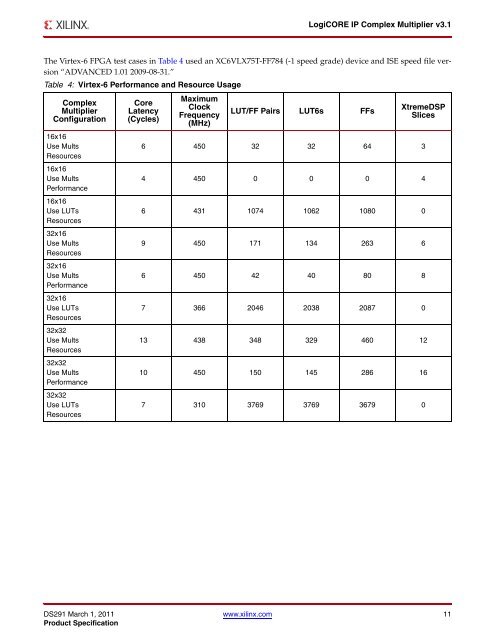Xilinx DS291, LogiCORE IP Complex Multiplier v3.1, Data Sheet
Xilinx DS291, LogiCORE IP Complex Multiplier v3.1, Data Sheet Xilinx DS291, LogiCORE IP Complex Multiplier v3.1, Data Sheet
Hardware Implementation Three Real Multiplier Solution LogiCORE IP Complex Multiplier v3.1 The three real multiplier implementation maps well to devices that have a pre-adder as part of the XtremeDSP slice (such as Spartan-6 and Virtex-6 FPGAs), saving slice resources. In general, the three multiplier solution uses more slice resources (LUTs/flip-flops) and have a lower maximum achievable clock frequency than the four multiplier solution. Four Real Multiplier Solution The four real multiplier solution makes maximum use of embedded multiplier/XtremeDSP slice resources, and has higher clock frequency performance than the three real multiplier solution, in many cases reaching the maximum clock frequency of the FPGA device. It still consumes slice resources for pipeline balancing, but this slice cost is always less than that required by the equivalent three real multiplier solution. LUT-based Solution The core offers the option to build the complex multiplier using LUTs only. While this option uses a significant number of slices, achieves a lower maximum clock frequency and uses more power than embedded multiplier/XtremeDSP slice implementations, it might be suitable for applications where embedded multipliers/XtremeDSP slices are in limited supply (such as Virtex-5 LX FPGAs), or where lower clock rates are in use. The three real multiplier configuration is used exclusively when LUT implementation is selected. Performance and Resource Usage Table 4 through Table 7 provide performance and resource usage information for a number of different core configurations. The maximum clock frequency results were obtained by double-registering input and output ports to reduce dependence on I/O placement. The inner level of registers used a separate clock signal to measure the path from the input registers to the first output register through the core. The resource usage results do not include the preceding “characterization” registers and represent the true logic used by the core to implement a single Complex Multiplier. LUT counts include SRL16s or SRL32s (according to device family) and LUTs used as route-throughs. The map options used were: "map -pr b -ol high" The par options used were: "par -ol high" Clock frequency does not take clock jitter into account and should be derated by an amount appropriate to the clock source jitter specification. DS291 March 1, 2011 www.xilinx.com 10 Product Specification
LogiCORE IP Complex Multiplier v3.1 The Virtex-6 FPGA test cases in Table 4 used an XC6VLX75T-FF784 (-1 speed grade) device and ISE speed file version “ADVANCED 1.01 2009-08-31.” Table 4: Virtex-6 Performance and Resource Usage Complex Multiplier Configuration 16x16 Use Mults Resources 16x16 Use Mults Performance 16x16 Use LUTs Resources 32x16 Use Mults Resources 32x16 Use Mults Performance 32x16 Use LUTs Resources 32x32 Use Mults Resources 32x32 Use Mults Performance 32x32 Use LUTs Resources Core Latency (Cycles) Maximum Clock Frequency (MHz) LUT/FF Pairs LUT6s FFs XtremeDSP Slices 6 450 32 32 64 3 4 450 0 0 0 4 6 431 1074 1062 1080 0 9 450 171 134 263 6 6 450 42 40 80 8 7 366 2046 2038 2087 0 13 438 348 329 460 12 10 450 150 145 286 16 7 310 3769 3769 3679 0 DS291 March 1, 2011 www.xilinx.com 11 Product Specification
- Page 1 and 2: Introduction The Xilinx LogiCORE IP
- Page 3 and 4: CORE Generator Graphical User Inter
- Page 5 and 6: XCO Parameters LogiCORE IP Complex
- Page 7 and 8: Rounding LogiCORE IP Complex Multip
- Page 9: X-Ref Target - Figure 4 BR BP +0111
- Page 13 and 14: LogiCORE IP Complex Multiplier v3.1
- Page 15: Support LogiCORE IP Complex Multipl
<strong>LogiCORE</strong> <strong>IP</strong> <strong>Complex</strong> <strong>Multiplier</strong> <strong>v3.1</strong><br />
The Virtex-6 FPGA test cases in Table 4 used an XC6VLX75T-FF784 (-1 speed grade) device and ISE speed file version<br />
“ADVANCED 1.01 2009-08-31.”<br />
Table 4: Virtex-6 Performance and Resource Usage<br />
<strong>Complex</strong><br />
<strong>Multiplier</strong><br />
Configuration<br />
16x16<br />
Use Mults<br />
Resources<br />
16x16<br />
Use Mults<br />
Performance<br />
16x16<br />
Use LUTs<br />
Resources<br />
32x16<br />
Use Mults<br />
Resources<br />
32x16<br />
Use Mults<br />
Performance<br />
32x16<br />
Use LUTs<br />
Resources<br />
32x32<br />
Use Mults<br />
Resources<br />
32x32<br />
Use Mults<br />
Performance<br />
32x32<br />
Use LUTs<br />
Resources<br />
Core<br />
Latency<br />
(Cycles)<br />
Maximum<br />
Clock<br />
Frequency<br />
(MHz)<br />
LUT/FF Pairs LUT6s FFs<br />
XtremeDSP<br />
Slices<br />
6 450 32 32 64 3<br />
4 450 0 0 0 4<br />
6 431 1074 1062 1080 0<br />
9 450 171 134 263 6<br />
6 450 42 40 80 8<br />
7 366 2046 2038 2087 0<br />
13 438 348 329 460 12<br />
10 450 150 145 286 16<br />
7 310 3769 3769 3679 0<br />
<strong>DS291</strong> March 1, 2011 www.xilinx.com 11<br />
Product Specification



